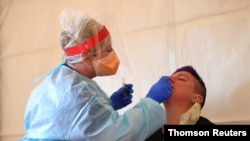The coronavirus pandemic has prompted Australia to cut its annual acceptance of refugees from 18,750 to 13,750, effective immediately. Official documents suggest the cuts to the humanitarian program will save almost $700 million.
Australia has a long history of accepting the displaced for resettlement. Since 1945, it has given sanctuary to more than 800,000 refugees. However, the government has said the financial consequences of the pandemic have forced it to cut the annual quota by 5,000 people, to 13,750.
The Refugee Council of Australia called the announcement "shattering."
“We were probably expecting that there might be some short-term reduction,” said Chief Executive Paul Power. “What we were not expecting was that the government would cut the program over the next three years and use that as a budget-saving measure.”
Australia closed its borders to foreign nationals, including refugees and migrants, to curb the spread of COVID-19 in March. Officials have indicated the restrictions could remain until late next year.
The government said it will spend about $9 million to help young refugees find work and adapt to life in Australia through community programs.
Australia is also cutting its skilled migration program, but priority will be given to innovators, investors, and job creators as the nation faces its first recession since the early 1990s.
Canberra will also insist that foreign partners of existing Australian residents pass an English language test before they are given a permanent visa.
The controversial immigration requirement would apply from mid-2021.
“We will require an applicant and a sponsor to have met functional-level English, or to have at least made reasonable efforts to learn English, and by reasonable efforts we mean for most people that would be doing about 500 hours of free English language classes,” said Acting Immigration Minister Alan Tudge.
Thirty percent of the Australian population was born overseas. In 2019, every single country from around the world was represented in Australia. The largest groups of migrants come from England, China and India.
Australia has been built on successive waves of immigration, but it retains an uncompromising stance on asylum-seekers arriving by boat, who are denied entry and transported to processing camps in the South Pacific.









